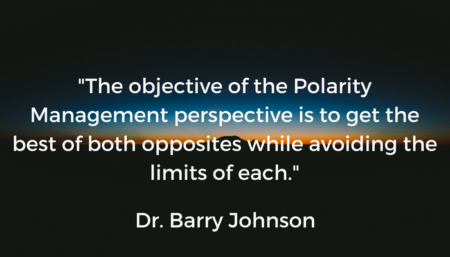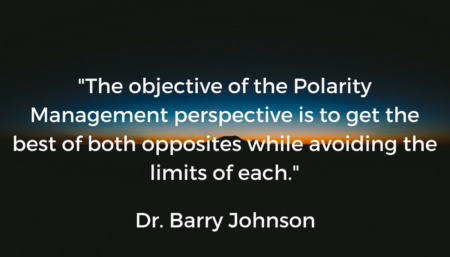
This guest post is an excerpt from Dr. Barry Johnson’s book Polarity Management: Identifying and Managing Unsolvable Problems Polarity Management. It is the companion to the Voice America Interview Leveraging Polarities in Complex and Turbulent Times.
I have some bad new and some good news. The bad news is that there are a large number of unsolvable problems in your life, both at work and at home. I’m not talking about difficulties you could solve if you had more money, time, or other resources. I’m talking about difficulties that are inherently unsolvable-ones you cannot solve with resources.
The good news is that you can stop trying to solve them. Instead, you can improve your skills in identifying unsolvable problems and managing them well. That is what this book is all about.
Current trends are Polarities to Manage
Many of the current trends in business and industry are polarities to manage, not problems to solve. These trends are often described as movement from one way of thinking or acting to another. For example, it is currently popular to move
- From neglecting the customer to focusing on the customer;
- From individual to team;
- From competition to collaboration;
- From centralization to decentralization;
- From a lack of quality consciousness to high quality consciousness;
- From rigid structures to flexible arrangements;
- From autocratic management to participatory management.
These trends are making a contribution to increased effectiveness and are important for organizational survival. Seeing these movement as “problems to solve” radically undermines our ability to implement them. We define the problem as what we are going from and the solutions as what we are going to. For example, “We need to move from the problem of centralization to the solution, which is decentralization.”
Polarity Management
I suggest that each of these trends is better understood as a polarity to manage. As such, Polarity Management principles can be very helpful. Our problem-solving skills and the whole problem-solving paradigm, while extremely useful with solvable problems, can get in the way when we have a polarity to manage.
A different paradigm, Polarity Management skills are a helpful complement to your problem-solving skills. You have been managing polarities all your life, some with more success than others. This book will enhance your ability to manage polarities, for those situations that call for it by offering a model and a set of principles as an alternative to problem solving.
Polarities to manage are sets of opposites that can’t function well independently. Because the two sides of a polarity are interdependent, you cannot choose one as a “solution” and neglect the other. The objective of the Polarity Management perspective is to get the best of both opposites while avoiding the limits of each.
For example, we constantly send managers off to “charm school” because they are too rigid (problem), and we want them to be more flexible (solution). The reason why managers often resist such training is that there is something they value about what is being called “rigid”. They value clarity. Furthermore, there is something they are afraid of in this push toward “flexibility.” They are afraid of “ambiguity”. Those who resist know that flexibility alone is not a solution. A leader needs to be clear and flexible. This is a polarity to manage, not a problem to solve. The issues become “How do you bring adequate clarity to a situation without being rigid?” and “How do you bring adequate flexibility to the same situation without being ambiguous?”
This becomes relevant only after letting go of the problem-solving paradigm where the problem is a rigid manager and the solution is to get the manager to become more flexible. The Polarity Management perspective involves seeing a more complete picture of the situation and respecting the wisdom of those who are resisting our “solutions.”
Polarity Management Skills Will Make You a More Effective Leader
Polarity Management skills will make you a more effective leader and manager by:
- Increasing your ability to distinguish between problems you can solve and those you cannot; and
- Increasing your ability to manage those unsolvable problems that I call workplace dilemmas or polarities
You will be more effective for the following reasons:
- You will save time and energy by not trying to solve those difficulties that are unsolvable.
- You will have a better understanding of resistance to organizational changes you want to make.
- You will be more effective in negotiating with those opposing your changes.
- You will be more effective in negotiating with those who are proposing changes you do not want.
- You will be more effective as a third-party mediator. This is especially true in conflicts where two groups are stuck in a polarity – they are treating the polarity as if it is a problem to solve.
- You will be able to anticipate and minimize problems that occur when workplace dilemmas, or polarities, are not managed well.
- Your decision making will improve. This is especially true with decisions where you must choose both sides of a set of apparent opposites.
Enough of list making. Please check out the interview with Barry giving more in-depth information about polarities and examples of how they can be used.
As a reader of this blog and listener to the interviews, please consider enrolling in one of the innovative leadership online leader development program. For additional tools, we recommend taking leadership assessments, using the Innovative Leadership Fieldbook and Innovative Leaders Guide to Transforming Organizations, and adding coaching. We also offer several workshops to help you build these skills.
About the author
In 1975, Dr. Barry Johnson created the first Polarity Map® and set of principles. Since then he has been learning, with clients, how to leverage polarities. Polarity Partnerships’ Mission is to enhance our quality of life on the planet by supplementing “OR Thinking” with “AND Thinking.” Barry has shared polarities with tens of thousands of individuals, senior leaders, executive teams. In 1992, he wrote Polarity Management®: Identifying and Managing Unsolvable Problems (HRD Press). His new book: AND, How to Leverage Polarity/Paradox/Dilemma is available for advanced reading as its being written. Go to www.polaritypartnerships.com for more information.





